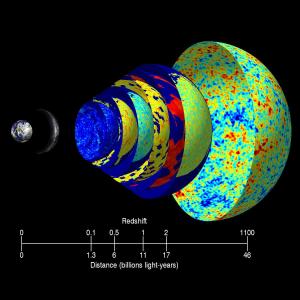Blog
North of the
North Pole
16 February 2014
 Daniel R. Strebe
Daniel R. StrebeSuppose someone were to ask you what was north of the North Pole. You might explain that the question is a bit nonsensical. The North Pole is a point on the Earth defined by our planet’s axis of rotation. The Earth is actually round, and all lines pointing north eventually converge at the North Pole. There isn’t actually anything north of the North Pole. There’s a similar question often asked of astrophysicists: what happened before the big bang?
Implicit in the question is that asking about “before” the big bang is like asking about “before” yesterday. In our everyday lives there is alway a before, just as in our everyday lives we can always take a step north. But the big bang is the limit of how far back in time we can observe, just as the north pole is as far north as we can go.
There is a common view that the big bang occurred at a point. While it is true that the observable universe was once small enough to fit in the palm of your hands, this isn’t a particularly good view of the big bang, because the big bang didn’t begin at a point, it began everywhere.
 NASA/ESA
NASA/ESAYou can get an idea of this in the figure. Because of the finite speed of light, as we look at more distant objects we also look into the past. So the light of nearby galaxies is millions of years of years old, that of more distant galaxies is billions. Beyond the farthest galaxy is the cosmic microwave background, which is the thermal remnant of the big bang. Beyond that, in every direction you could possibly look, lies the big bang. Of course we can’t see beyond the cosmic microwave background, because the early universe was so hot and dense that it wasn’t transparent.
Despite our inability to directly observe beyond the cosmic microwave background, we do know quite a bit about the time before it. We know, for example, the temperature at which atoms began to form. We know that there was an early inflationary period. And we know the universe did not begin as a singularity. The observable universe was once small, but it did not begin as a point of zero volume. In fact, because of inflation it is possible that the universe did not begin at a single point in time. We also know to the limits of our observations that the universe has no overall curvature. That means the universe must be much larger than the region we can observe. As best we can tell, the universe is infinite in size.
If the universe is infinite in size and has no clear first moment in time, then what happened before the big bang? What lies beyond infinity? What is north of the North Pole?